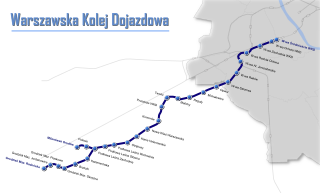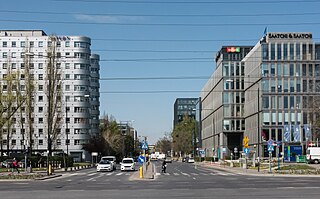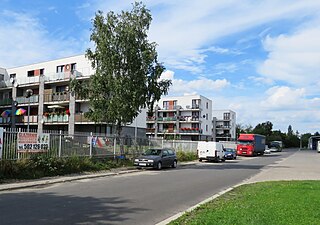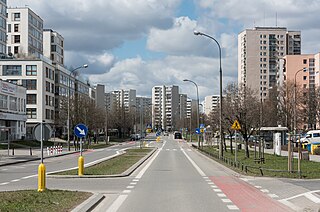
Warsaw Chopin Airport is an international airport in the Włochy district of Warsaw, Poland. It is the busiest airport in Poland and the 31st busiest airport in Europe with 18.5 million passengers in 2023, handling approximately 40% of the country's total air passenger traffic. The airport is a central hub for LOT Polish Airlines as well as a base for Enter Air and Wizz Air.

Warsaw Commuter Railway is a light rail commuter line in Poland's capital city of Warsaw. The line, together with its two branches, links Warsaw with the municipalities of Michałowice, Pruszków, Brwinów, Podkowa Leśna, Milanówek and Grodzisk Mazowiecki to the south-west of Warsaw.

Włochy is one of the districts of Warsaw, located in the south-western part of city. Włochy borders districts Bemowo and Wola from the north, Ochota and Mokotów from the east, and Ursus and Ursynów from the south. It is one of 3 neighborhoods with the title of a garden town.

Wyględów is a neighbourhood, and the City Information System area, located in Warsaw, Poland, within the district of Mokotów.

Służewiec is a neighbourhood, and an area of the City Information System, in the city of Warsaw, Poland, located within the district of Mokotów. Most of the neighbourhood consists of office buildings, which form one of the biggest complexes of office buildings in Poland, and one of the most important office centres in the city. It contains many headquarters of branches of many domestic and multinational corporations. A small portion of the neighbourhood also forms a residential area with apartment buildings.

Warszawa Włochy railway station is a railway station in the Włochy district of Warsaw, Poland. It stands on the junction of lines 1 and 3: from here trains can either run on Line 1 towards Łódź or Line 3 towards Poznań. It comprises two platforms connected by an undeground pedestrian tunnel and a station building complete with ticket machines and bicycle parking.

Staw Zbarski is a small pond in Warsaw in the district of Włochy.

Jelonki, prior to 1951 known as Jelonek, is a residential neighbourhood in the city of Warsaw, Poland, located within the district of Bemowo. The City Information System divides the neighbourhood into two areas, Jelonki Północne and Jelonki Południowe.

Odolany is a neighbourhood, and an area of the City Information System, in the city of Warsaw, Poland, located within the district of Wola.

Dąbrówka is a municipal neighbourhood, and a City Information System area, in Warsaw, Poland, within the district of Ursynów. It is a residencial area, consisting of single-family housing.

Załuski is a neighbourhood, and an area of the City Information System, in the city of Warsaw, Poland, located within the district of Włochy.

Salomea is a neighbourhood, and an area of the Municipal Information System, in the city of Warsaw, Poland, located within the district of Włochy.

Wiktoryn is a residential neighbourhood in the city of Warsaw, Poland, located within the district of Włochy, in the City Information System area of Stare Włochy.

Wyczółki is a neighbourhood, and a City Information System area, located in Warsaw, Poland, within the district of Ursynów. It is a mixed area, consisting of residencial zones, as well as business office complexes and storage warehouses.

Grabów is a neighbourhood, and a City Information System area, located in Warsaw, Poland, within the district of Ursynów. It consists mostly of the low-rise residential buildings.

Krasnowola is a neighbourhood in Warsaw, Poland, located within the district of Ursynów, in the City Information System area of Grabów. It is centred around Krasnowolska Street, and mostly consists of single-family detached homes.

Jeziorki is a municipal neighbourhood in Warsaw, Poland, located within the district of Ursynów. It is encompassed within two areas of the City Information System: Jeziorki Północne and Jeziorki Południowe, and is traditionally divided into two parts: Nowe Jeziorki, and Jeziorki Polskie. The neighbourhood is a residencial area of lowrise single-family housing.

Stary Imielin, also known as West Ursynów, is a neighbourhood, and a City Information System area, located in Warsaw, Poland, within the district of Ursynów.

Ursynów-Centrum, also known as South Ursynów, is a neighbourhood, and a City Information System area, located in Warsaw, Poland, within the district of Ursynów.

Na Skraju is a neighbourhood in Warsaw, Poland, located within the district of Ursynów, in the eastern portion of the City Information System area of Ursynów-Centrum.






















